A comparative neuroanatomical study of the red nucleus of the cat, macaque and human
- PMID: 19675676
- PMCID: PMC2722087
- DOI: 10.1371/journal.pone.0006623
A comparative neuroanatomical study of the red nucleus of the cat, macaque and human
Abstract
Background: The human red nucleus (Nr) is comparatively less well-studied than that of cats or monkeys. Given the functional importance of reticular and midbrain structures in control of movement and locomotion as well as from an evolutionary perspective, we investigated the nature and extent of any differences in Nr projections to the olivary complex in quadrupedal and bipedal species. Using neuroanatomical tract-tracing techniques we developed a "neural sheet" hypothesis allowing us to propose how rubro-olivary relations differ among the three species.
Methods and findings: Wheat germ agglutinin-horseradish peroxidase staining supports findings that the cat's nucleus accessories medialis of Bechtrew (NB) projects mainly to the lateral bend of the principal olive. We clarified boundaries among nucleus of Darkschewitsch (ND), NB and parvicellular red nucleus (pNr) of the cat's neural sheet. The macaque's ND-medial accessory olivary projection is rostro-caudally organized and the dorsomedial and ventrolateral parts of the macaque's pNr may project to the principal olive's rostral and caudal dorsal lamella; in cat it projects as well to pNr. Myelin- and Nissl-stained sections show that a well-developed dorsomedial part of the human Nr consists of densely packed cells, deriving small myelinated fibers that continue into the medial central tegmental tract.
Conclusions: Based on these findings we suggest there are distinct bipedal-quadrupedal differences for Nr projections to the olivary complex. We propose the Nr of cats and monkeys comprise the ND, NB and pNr in a zonal sheet-like structure, retaining clear nuclear boundaries and an isolated, well-developed mNr. The human NB may be distinguished from its more specialised ND (ND lies alongside a well-developed pNr) in the human central gray. Phylogenetically, the NB may have been translocated into a roll-shaped Nr in the reticular formation, the dorsomedial portion of which might correspond to the cat's and monkey's NB.
Conflict of interest statement
Figures



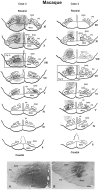


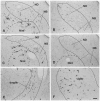
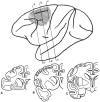

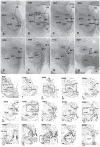

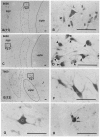
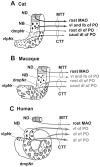
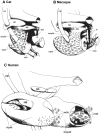

Similar articles
-
The mammalian red nucleus and its role in motor systems, including the emergence of bipedalism and language.Prog Neurobiol. 2012 Feb;96(2):165-75. doi: 10.1016/j.pneurobio.2011.12.002. Epub 2012 Jan 2. Prog Neurobiol. 2012. PMID: 22230734 Review.
-
Olivary projections from the mesodiencephalic structures in the cat studied by means of axonal transport of horseradish peroxidase and tritiated amino acids.J Comp Neurol. 1984 Jul 20;227(1):37-49. doi: 10.1002/cne.902270106. J Comp Neurol. 1984. PMID: 6470209
-
A reevaluation of midbrain and diencephalic projections to the inferior olive in rat with particular reference to the rubro-olivary pathway.J Comp Neurol. 1984 Oct 20;229(2):285-300. doi: 10.1002/cne.902290213. J Comp Neurol. 1984. PMID: 6209303
-
Descending projections to the inferior olive from the mesencephalon and superior colliculus in the cat. An autoradiographic study.Exp Brain Res. 1982;45(3):333-48. doi: 10.1007/BF01208593. Exp Brain Res. 1982. PMID: 7067770
-
Projections from the red nucleus and surrounding areas to the brainstem and spinal cord in the cat. An HRP and autoradiographical tracing study.Behav Brain Res. 1988 Apr-May;28(1-2):33-57. doi: 10.1016/0166-4328(88)90075-7. Behav Brain Res. 1988. PMID: 3382519
Cited by
-
Corollary discharge in precerebellar nuclei of sleeping infant rats.Elife. 2018 Dec 5;7:e38213. doi: 10.7554/eLife.38213. Elife. 2018. PMID: 30516134 Free PMC article.
-
Red nucleus structure and function: from anatomy to clinical neurosciences.Brain Struct Funct. 2021 Jan;226(1):69-91. doi: 10.1007/s00429-020-02171-x. Epub 2020 Nov 12. Brain Struct Funct. 2021. PMID: 33180142 Free PMC article. Review.
-
Morphological Features of Human Dendritic Spines.Adv Neurobiol. 2023;34:367-496. doi: 10.1007/978-3-031-36159-3_9. Adv Neurobiol. 2023. PMID: 37962801 Review.
-
Reactive and Proactive Adaptation of Cognitive and Motor Neural Signals during Performance of a Stop-Change Task.Brain Sci. 2021 May 11;11(5):617. doi: 10.3390/brainsci11050617. Brain Sci. 2021. PMID: 34064876 Free PMC article. Review.
-
Cerebro-Cerebellar Networks in Migraine Symptoms and Headache.Front Pain Res (Lausanne). 2022 Jul 13;3:940923. doi: 10.3389/fpain.2022.940923. eCollection 2022. Front Pain Res (Lausanne). 2022. PMID: 35910262 Free PMC article. Review.
References
-
- Ogawa T. The tractus tegmenti medialis and its connection with the inferior olive in the cat. J Comp Neurol. 1939;70:19–36.
-
- Mannen H. A dendro-cyto-myeloarchitectonic atlas of cat's brain. 1988. Tokyo: Iwanami Shoten.
-
- Onodera S. Olivary projections from the mesodiencephalic structures in the cat studied by means of axonal transport of horseradish peroxidase and tritiated amino acids. J Comp Neurol. 1984;227:37–49. - PubMed
-
- Drew T, Jiang W, Kabiy B, Lavoie S. Role of the motor cortex in the control of visually triggered gait modifications. Can J Physiol Parmacol. 1996;74:426–442. - PubMed
-
- Lavoie S, Drew T. Discharge characteristics of neurons in the red nucleus during voluntary gait modifications: a comparison with the motor cortex. J Neurophysiol. 2002;88:1791–1814. - PubMed
Publication types
MeSH terms
LinkOut - more resources
Full Text Sources
Miscellaneous

